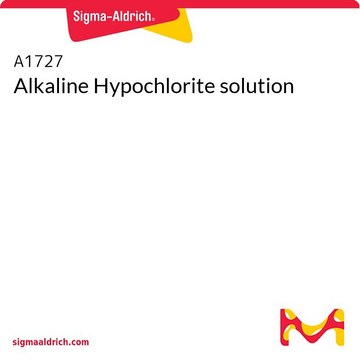239305
Sodium hypochlorite solution
reagent grade, available chlorine 4.00-4.99 %
Sign Into View Organizational & Contract Pricing
All Photos(1)
About This Item
Linear Formula:
NaClO
CAS Number:
Molecular Weight:
74.44
EC Number:
MDL number:
UNSPSC Code:
12352300
PubChem Substance ID:
NACRES:
NA.21
grade:
reagent grade
form:
liquid
Recommended Products
grade
reagent grade
Quality Level
Agency
suitable for SM 4500 - NH3
vapor pressure
17.5 mmHg ( 20 °C)
form
liquid
composition
available chlorine, 4.00-4.99%
reaction suitability
reagent type: oxidant
concentration
4.00-4.99% (chlorine by Na2S2O3, titration)
density
1.097 g/mL at 25 °C
storage temp.
2-8°C
SMILES string
[Na+].[O-]Cl
InChI
1S/ClO.Na/c1-2;/q-1;+1
InChI key
SUKJFIGYRHOWBL-UHFFFAOYSA-N
Looking for similar products? Visit Product Comparison Guide
Related Categories
General description
Sodium hypochlorite (NaOCl) is a commonly used reagent in organic synthesis for many oxidation and chlorination reactions.
Application
Sodium hypochlorite solution can be used as an oxidizing agent for the oxidation of:
It can also be used as a reagent in the:
- Primary alcohols to aldehydes or carboxylic acids and secondary alcohols to ketones.
- Aryl aldehydes to the corresponding acids in the presence of a phase-transfer catalyst.
- Ethers to esters by careful pH control (pH range of 8–9.5),
It can also be used as a reagent in the:
- Epoxidation of enones and polycyclic arenes.
- Oxidative degradation reaction
- N-Chlorination of primary and secondary amines
- Enantioselective epoxidation of α, β-unsaturated ketones
- Asymmetric dihydroxylation of olefins in the presence of an osmium catalyst
- Chlorination of allylic carbons in the presence of CeCl3
Features and Benefits
- Readily available reagent
- Easily handled oxidizing agent
- No phase-transfer catalyst is necessary for the oxidation of substrates in the pH range 10–11
- Simplified waste disposal and lower toxicity
Disclaimer
“The product is not intended for use as a biocide under global biocide regulations, including but not limited to US EPA′s Federal Insecticide Fungicide and Rodenticide Act, European Biocidal Products Regulation, Canada’s Pest Management Regulatory Agency, Turkey’s Biocidal Products Regulation, Korea’s Consumer Chemical Products and Biocide Safety Management Act (K-BPR) and others.”
Signal Word
Danger
Hazard Statements
Precautionary Statements
Hazard Classifications
Aquatic Acute 1 - Aquatic Chronic 2 - Eye Dam. 1 - Skin Irrit. 2
Storage Class Code
12 - Non Combustible Liquids
WGK
WGK 2
Flash Point(F)
Not applicable
Flash Point(C)
Not applicable
Choose from one of the most recent versions:
Already Own This Product?
Find documentation for the products that you have recently purchased in the Document Library.
Customers Also Viewed
Collection of Root Exudate from Duckweed.
Lu Y, et al.
Bio-protocol, 5(1) (2015)
Isolation of Epithelial Cells from Mouse Gastrointestinal Tract for Western Blot or RNA Analysis.
Zeineldin M and Neufeld K.
Bio-protocol, 2(22) (2012)
Bingying Leng et al.
Plant science : an international journal of experimental plant biology, 302, 110704-110704 (2020-12-09)
Arabidopsis thaliana TRY is a negative regulator of trichome differentiation that promotes root hair differentiation. Here, we established that LbTRY, from the recretohalophyte Limonium bicolor, is a typical MYB transcription factor that exhibits transcriptional activation activity and locates in nucleus.
In vivo evaluation of chlorhexidine gluconate solution and sodium hypochlorite solution as root canal irrigants.
A M Ringel et al.
Journal of endodontics, 8(5), 200-204 (1982-05-01)
B R Johnson et al.
Journal of endodontics, 19(1), 40-43 (1993-01-01)
Although the tissue solvent and bactericidal properties of sodium hypochlorite are well known, the effective shelf-life of prepared sodium hypochlorite solutions is not known. The stability of sodium hypochlorite is adversely affected by exposure to high temperature, light, air, and
Our team of scientists has experience in all areas of research including Life Science, Material Science, Chemical Synthesis, Chromatography, Analytical and many others.
Contact Technical Service





